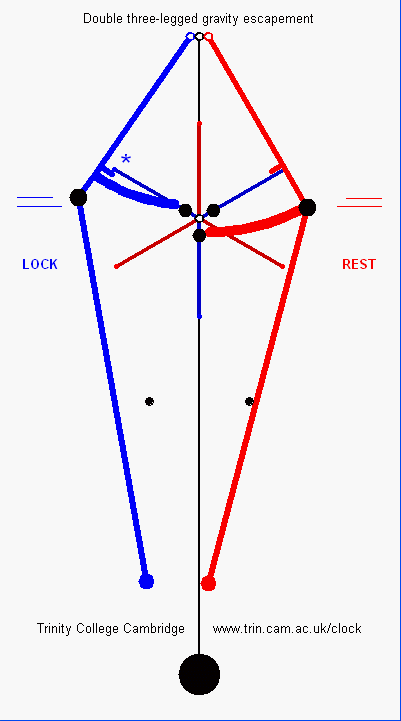The Gravity Escapement
The "escapement" is the part of a clock that converts the energy of the falling drive weight into impulses that keep the pendulum swinging. It also transfers energy from the falling weight to drive the clock dials that show the time. The falling weight turns the hands, and the pendulum regulates that motion to occur at accurate intervals of time. The Seth Thomas tower clock uses a "double 3-legged gravity escapement", which is commonly used in tower clocks. Shown here is an animation created by Hugh Hunt at Trinity College in Cambridge, England. In this illustration the pendulum is represented by the black line in the center. It swings back and forth. The thick blue and red arms at each side of the figure are the "gravity arms". The gravity arms push the pendulum at their bottom ends. The short blue and red spokes that rotate in the center of the illustration are the "legs" of the escapement. The drive weight of our clock hangs on a chain and weighs about 200 pounds. As it falls, it keeps tension on the six escapement legs to turn in a counter clockwise direction. But they are not free to spin because they run into two short platforms (called "pallets") on the gravity arms. Whether or not the escapement legs will run into one of these pallets depends on whether that gravity arm has swung in or out. When one of the six legs lands on a pallet, it is said to the "locked". Near the center of rotation of the six legs are three round black posts ("lift pins") that rotate with the legs. As these posts turn, they push out on a curved portion of the gravity arms, to raise the arm a little bit. When the pendulum comes along, it raises the gravity arm even farther. When a gravity arm has been pushed out far enough, the leg will slip off the pallet (this is called "unlocking") and the legs will rotate counter clockwises until another leg "locks" on the pallet of the other gravity arm. As the pendulum swings back the other way, it is pushed by the bottom end of the falling gravity arm. This push is what keeps the pendulum swinging. People often think the pendulum is what drives a clock. But it is the clock weight that drives the pendulum. The purpose of the pendulum is to regulate the rotation of the clock to precise intervals of time. This is a unique ability that pendulums have, and it was first observed by Galileo around 1602. A pendulum was first used in a clock 54 years later by the Dutch scientist Christiaan Huygens.
The following movie is a slow motion (1/3 speed) movie of the double 3-legged gravity escapement in the Santa Barbara Courthouse tower clock. You'll need to have QuickTime installed to see it. As the pendulum swings to the left, the left side pallet slips out from under the leg of the escapement (it "unlocks") and the six legs begin to rotate counter clockwise, until one of the legs "locks" on the pallet of the right-side gravity arm. The pendulum then swings back to the right and gets its "impulse" from the bottom end of the left gravity arm. The pendulum lifts the right gravity arm and the leg unlocks from its pallet. The legs rotate counter clockwise until one of them locks on the left gravity arm. The pendulum then swings to the left again and gets an impulse from the right gravity arm. And so on. But there's more detail to this action than is at first obvious. You can watch the pendulum raise the gravity arm, and get pushed back down as the arm falls. When the pendulum has to raise the gravity arm, it loses energy. When the gravity arm pushes it back down, it puts energy back into the pendulum. So how does the pendulum end up with "extra" energy to keep it going? Watch the movie again closely. As the pendulum pushes the left gravity arm up, the right gravity arms moves a little bit to the right and then stops. When the pendulum raises the right gravity arm, the left gravity arm moves a little bit to the left and then stops. These little bits of extra movement account for the real impulse to the pendulum. The three "lift pins" near the center of the escape wheel push out the gravity arms this little bit. The energy to do this comes from the falling weight that drives the clock. When the pendulum swings down under the weight of the gravity arm, it swings a little bit farther than it raised the arm up because the arm was "pre-raised" a little bit by the lift pins.
|
